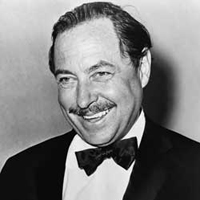Illusion and the Grotesque in Cat on a Hot Tin Roof
The play depicts the feeling and the consequences of greed, frustration, guilt, desire and hypocrisy, but most importantly, it deals with the conflict between appearance and reality and its resolution in truth. Williams is concerned with man's drive to escape his problems either by totally ignoring them or by affecting a facade of illusion. He emphasizes this need in the opening of the work with a symbolic stage prop "a very complete and compact listen shrine to virtually all the comforts and illusions behind which we hide from such things as the characters in the play are faced with".

Tennessee Williams (1911-1983)
It is this veil of illusion that permits human beings to cope with the "Slow and implacable fires of desperation". Williams intensifies the growing despair in this play by giving it a stifling, almost enclosed atmosphere. Maggie refers again and again to the lack of privacy in this wealthy southern family, to the "cage" which is their home. Such a feeling of heightening restriction only heightens. The frantic attempts of these characters to avoid reality and increase the likelihood of an inevitable, shattering destruction of illusion.
Thus, the pervading theme of Williams' drama involves the tension between truth and mendacity, the gradual stripping away of pretense with the ultimate consequences, and the playwright employs various devices to achieve both illusion and exposure. One of his most effective techniques is a use of the grotesque, a term which is an outgrowth of the contemporary distrust of any cosmic order an interest in the irrational, and a frustration at man's position in the universe. In a sense, then the grotesque is a merging of the comic and tragic, through physical or spiritual deformity and abnormal action, and individual reflect both a comic deviation from the rational social order and a tragic loss of faith in the moral universe. Williams makes use of the grotesque in the minor characters of his play, figures whose absurd appearance reflects a deformed soul. One such figure is the Reverend Tooker, the personification of religious hypocrisy. Sending with vulture like accuracy the presence of decay, the Reverend is simply waiting for Big Daddy to die. Attempting to hide his greed with platitudes and weak jokes, the minister nevertheless reveals his obsession with money by his constant references to Church donations and memorials for the dead. This grotesque hypocrisy is ever more predominant in the portraits of Mae, Gooper, and the title, "no-neck monsters." The elder son and his wife have a desire to inherit Big Daddy's money before his death; their rapaciousness is apparent not only in their silly chatter and overzealous efforts to please, but also in the actual use of their children as devices to draw the old man's attention by emphasizing their fertility in contrast to the sterility of Brick and Maggie. The grotesque antics which Mae and Gooper put themselves and their children through a frenzied attempt to win approval are so absurd as to become pitiful. In addition to the children's overall resemblance to an "animal act in a circus," their absurdity is climaxed with a song-and-dance routine for Big Daddy, arranged and conducted by Mae. The general impression of these senses is one of ridiculous farce. The playwright depicts these figures in the light of their respective abilities to face and cope with reality: of the three, Brick is least able to comfort truth. Perhaps the most striking example of his denial of the truth is revealed in his refusal to face his feeling of guilt, the obsession which renders him grotesque. He unequivocally refutes any hint of an unnatural love in his intense relationship with Skipper, rejecting his friend's tortured confession and stubbornly insisting that their feeling for each other was the only "pure an' true" thing in his life. As Big Daddy points out, "You! -- dug the grave of your friend and kicked him in it! -- before you'd face truth with him." Thus Brick's disgust with mendacity is actually disgusted with himself.
Brick retorts to his father, "Who can face truth? Can you? This question goes straight to the heart of Big Daddy's character for the old man is very capable of confronting the truths of those around him but not his own. More importantly, Maggie is able to confront unflinchingly truths about herself. She confesses to her husband. "Brick, I'm not good. I don't know why people have to pretend to be good, nobody's good." Maggie knows that her frenzied desire for money and security is a result of the deprivation of both as a child. She is willing to confront her own loneliness, her husband's indifference toward her, and her part in the skipper-Brick affair, for it is Maggie who forces the confrontation between Brick and Skipper. She accepts the responsibility for her actions, the guilt and the loneliness that come with living with someone "I' love" who "doesn't love you." She has acquired the poise of the cat caught on a hot tin roof and is able to recognize the situation as a metaphor for living.
Cat on a Hot Tin Roof Study Center
Maggie as a Cat in Cat on a Hot Tin Roof
The Maggie-Brick Relationship in Cat on a Hot Tin Roof
Sexual Struggle and Conflict in Cat on a Hot tin Roof
Homosexuality the Problem in Brick in Cat on a Hot Tin Roof
Isolation and the Lack of Communication in Cat on a Hot Tin Roof
Cat on a Hot Tin Roof
Introduction of Cat on a Hot Tin Roof
Summary of Cat on a Hot Tin Roof
Dramatic Technique in Cat on a Hot Tin Roof
Biography of Tennessee Williams
 |
bachelorandmaster.com |